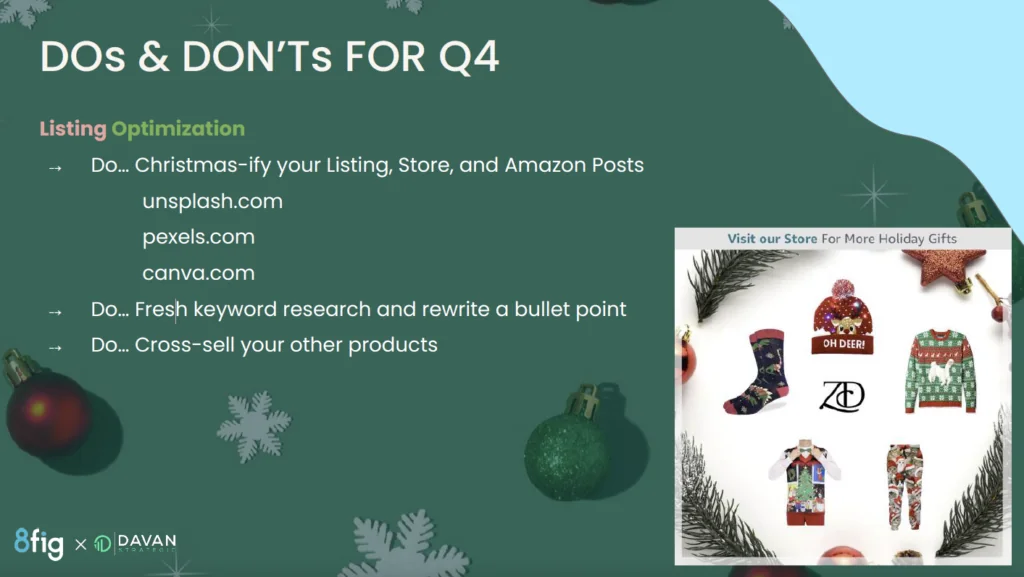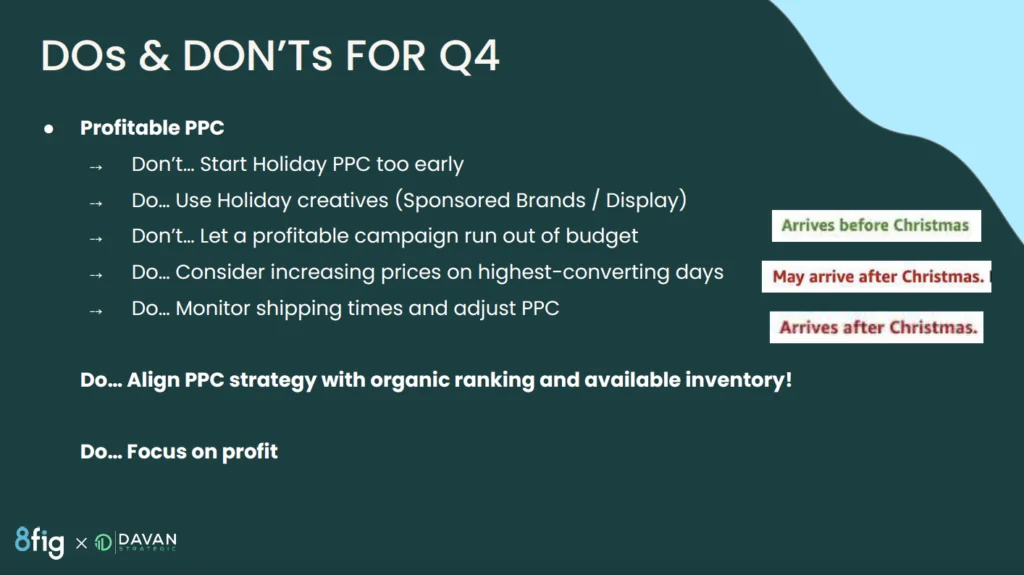Ryan Sherrard and David Lang started selling on Amazon in 2020. When they needed funding, they turned to 8fig’s unique solution, and were able to scale their business to seven figures in less than two years. They recently sold their brand for several million dollars, and now help other eCommerce sellers succeed through their business, DAVAN Strategic.
Ryan and David joined host Emma Borochoff, Head of Marketing at 8fig, for an enlightening webinar on how to navigate peak selling season like a pro.
Watch the full webinar above, or read on for a summary of their helpful tips and advice. If you want to check out the full presentation they shared, click here.
Dos and don’ts for peak selling season
Emma kicked off the webinar with one of the questions we’ve been hearing a lot lately: what are some of the biggest mistakes sellers make in Q4?
Ryan started off with a few “dos”. He advised sellers to revisit their listing optimization and Christmas-ify their listings, store, and Amazon posts. “You can make any product a holiday product,” David added.
In addition, Ryan stressed the importance of doing fresh keyword research each year. It’s also a good idea to add a cross-sell photo highlighting your entire product catalog to encourage people to buy more from your brand. Many people haven’t yet decided what gifts to buy for everyone on their lists, so giving them ideas from your store can increase sales.
Moving on to “don’ts”, David addressed inventory storage fees. Since FBA storage fees increase significantly during Q4, David warned against sending inventory to FBA too early in order to avoid paying these extra fees. At the same time, don’t send them in too late or you’ll miss out on sales.

Check your inventory placement, too. Amazon has Supplemental Fulfillment Centers, where they sideline products they don’t think you’ll be able to sell right away. In order to fill a customer order, the inventory must be sent to the General Fulfillment Center, a process which can take several days. Only then is the product available for fast Prime delivery. Therefore, it’s important to make sure your inventory isn’t sidelined. There’s not much information out there on this topic, so check out David and Ryan’s video here.
PPC dos and don’ts
Ryan then moved on to PPC (pay per click) advice. He advised sellers not to start holiday PPC campaigns too early, to use holiday creatives in their PPC ads, not to let a profitable campaign run out of budget, and to monitor shipping times and adjust PPC accordingly. Once a “may arrive after Christmas” badge appears on your listing, it’s probably a good idea to pull back on some of that PPC spend.

Increasing your prices on the peak-selling days is a great way to offset the higher storage fees, since people are less price conscious once Christmas approaches.
Additionally, make sure to align your PPC strategy with organic ranking and available inventory, and don’t forget to focus on profit, not just revenue or number of units.
Viewer question: would you launch a new product during Q4?
According to David, it depends. If your product doesn’t require reviews to sell, go ahead and launch. But if you’re selling a competitive product where social proof is important, it might not be the best idea to launch in Q4. It’s also hard to determine your baseline sales, or how much you sell on an average day, when you launch during Q4.
Metrics to track during Q4
Next, Ryan and David addressed the metrics that sellers should look at to inform their Q4 strategy. In terms of profitability, they pay attention to TACOS (total advertising cost of sale), pricing, and organic ranking. When it comes to PPC, they track campaign budgets and placements. For inventory, they look at competitor inventory levels, shipping times, and restock limits.
Shipping times are particularly important, not just in terms of shipping times to the customer but also to FBA. That’s because if you send in inventory too late, you’ll miss the peak.
Viewer question: what should I do with my PPC when my product is going to sell out?
Again, David answered with “it depends”. If you’ll only be out of stock for a few weeks, you can keep pushing the product, making sure to close the listing once it sells out. But if you’re going to be out of stock for a few months, you might as well slow it down, raise prices slightly, and stop your PPC campaigns to maximize profits.
Amazon restock limits
Emma turned the conversation back to the topic of Amazon’s restock limits, asking how Ryan and David deal with lower limits. This is a big pain point for Amazon sellers.
Ryan pointed out that Amazon’s forecasting is not accurate. Since the restock limit is based off of this forecast, it’s a huge problem for sellers. Instead of trusting this, Ryan and David build their own forecasts.
David then addressed what they do when the restock limit is lowered. First, they open a ticket with Seller Support. Then, they have FBM (fulfilled by merchant) units on standby, utilizing a 3PL. When the Amazon restock limit is too low, they try to sell their FBM units first, saving their FBA units until peak time, when it really matters.
Finally, David advised adjusting your strategy from individual SKUs to whole parentages, focusing more on variations that you can stock and sell. For example, raise the price of a popular color variation so you don’t sell out of it.
Viewer question: when you go out of stock, will closing your listing preserve your ranking?
David answered that it does preserve your ranking, but it’s limited. You won’t bounce right back to your previous ranking, but the dropoff rate will be a bit slower. He added that they have strategically closed a listing for a day during a peak in order to avoid going out of stock and preserve ranking.
Viewer question: How are you maintaining a healthy cash flow during Q4?
There are two ways David and Ryan maintained a healthy cash flow in their business. The first was by tracking their expenses and revenue in detail using in-depth homemade Excel spreadsheets.
The second was with funding from 8fig. Working with 8fig pushed cash flow concerns to the back of David and Ryan’s minds. Since 8fig’s Growth Plans are based around cash flow, David and Ryan knew they had the working capital available to pay their purchase orders, shipping costs, or any other expenses. Only once the units were sold did their remittances kick in, on a personalized schedule.
“We’re not the best experts at how to plan cash flow because we literally had 8fig take care of it for us,” David told us.
DAVAN Strategic’s Stock Flow Spreadsheet
David and Ryan built an Excel spreadsheet to help them run their eCommerce business. They are now offering a version of their spreadsheet, which helps sellers track their inventory, to their community for free for a limited time. You can download this spreadsheet here or by scanning the QR code below:

Viewer question: do you recommend getting media placements, PR, or social media to boost traffic to Amazon listings along with PPC?
Ryan said that they reached out to gift guides last year in order to get placements outside of Amazon. Some bloggers will write up your product in exchange for just a free product, boosting traffic and brand awareness. It’s a great strategy for all peaks, too, but make sure to do it well in advance.
If you have a Shopify site, you can also run Google ads to your Shopify store. This boosts Amazon sales because many people will turn to Amazon to purchase a product or brand they’re interested in, even if they see it off of Amazon. Then, Amazon considers that traffic organic, and it helps your ranking.
Viewer question: What sort of changes do you make to your PPC strategy when selling for Mothers Day, Valentine’s Day, and other holidays versus the Q4 holiday season?
David jumped right in to remind the audience that there are different keywords for different holidays. Ryan added that each holiday each year requires fresh keywords. Another difference during the Q4 peak is the “arrives before Christmas” or “will not arrive before Christmas” badge, which only appears during this season. It’s important to pay attention to this because it should impact your PPC strategy. The Christmas peak also starts earlier than other peaks.
Viewer question: Is there any way around ineligible items for PPC?
If you really want to do PPC for that item, you can try to market it as something else, David advised. You can try to get it into a different category that is eligible for PPC. But be careful about changing your listing too much, because you might lose organic traffic from those who are searching for that product. You can also try to run ads elsewhere, such as Google, added Ryan.
Viewer question: Do you use the DataDive tool?
Ryan and David haven’t used the DataDive tool since they have their own spreadsheet. That being said, they do recommend it to other sellers. Remember, data is important but it’s also important to use your own analysis and judgment to think about the data.
Grow Your Business Like David and Ryan
Want to take your business to the next level like David and Ryan did? 8fig can help. Our all-in-one growth platform provides you with the funding and tools you need to scale your business. Our funding is continuous, flexible, and personalized to optimize your cash flow. Sign up for an 8fig Growth Plan today and find out how much you can sell once you no longer have to worry about working capital.